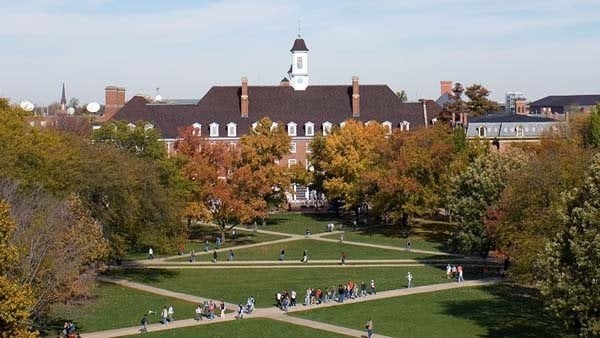You have /5 articles left.
Sign up for a free account or log in.

The University of Illinois at Urbana-Champaign would receive funding under a new university system proposal designed to break a state budget impasse.
University of Illinois
The University of Illinois System is ready to sacrifice future flexibility in order to end fiscal uncertainty that has persisted as a state budget stalemate continues into its second year.
The system is pinning its hopes on a deal that would have it agreeing to several performance-based funding metrics which would include limits on tuition increases, increased emphasis on in-state admissions and spending on enrolling in-state and underrepresented students. In exchange, the state would provide the three-university system with predictable annual funding over a five-year period, ease some regulatory restrictions and create a fund to recruit and retain faculty members.
University of Illinois System trustees last week backed the deal, labeled an Investment, Performance and Accountability Commitment. System leaders praised the idea as having the potential to end year-to-year uncertainty hampering planning efforts.
State lawmakers introduced legislation to codify the deal, and early reaction from faculty members on campuses has been generally positive. But the legislation’s success in deeply gridlocked Illinois is no sure thing, and some faculty members have voiced reservations about the idea of embracing metrics.
The university system is also offering up less than it seems at first glance, even as it may be limiting important funding options for the future. A closer look at the deal’s specifics shows the university system is already meeting many of the proposed performance metric cutoffs. University leaders would be limiting their ability to grow a source of revenue that has become important to many universities -- out-of-state enrollment, including international enrollment. And the university would be trading that potential revenue source to lock in state appropriations that do not rise to historical highs.
Under the proposal, the University of Illinois System would limit tuition and fee increases for in-state undergraduates to the rate of inflation as measured by the Consumer Price Index. It would admit at least 27,300 Illinois residents as first-time students or transfers into undergraduate programs at its Chicago, Springfield and Urbana-Champaign campuses. Illinois residents would also have to account for at least half of all on-campus undergraduate enrollment growth over 2015-16 levels.
In addition, the university system would have to post an 87 percent freshman retention rate in undergraduate programs and a six-year graduation rate of at least 72 percent. It is also offering to use 12.5 percent of its annual state funding for need-based financial aid for in-state undergraduates and to commit another $15 million in financial aid to attract students from underrepresented minority groups in Illinois.
In return, the state of Illinois would provide an appropriation of $662 million in the 2018 fiscal year. Legislators would renew the funding annually for the deal’s five-year term, increasing it by the rate of inflation each year. Plus, the state would put in place regulatory reforms such as easing procurement restrictions on the university. It would also set up a state-financed fund to invest in facility improvements for recruiting and retaining faculty members. Current legislative drafts do not specify the size of that fund.
The proposed $662 million matches the university system’s last full appropriation, made in the 2015 fiscal year before the budget impasse began. The university system points out that the proposed funding level is below the amount it received in state appropriations in the past, an amount that peaked at $804 million in the 2002 fiscal year. But it would be above stopgap funding the university received more recently. The state allotted the system $180 million in stopgap funding for the 2016 fiscal year and has so far allotted $350 million for the current fiscal year.
State funding is a relatively small portion of the University of Illinois System’s budget compared to other state institutions, like Chicago State University, that have suffered more heavily during the Illinois budget standoff. State revenues made up just 11.9 percent of the university system’s $5.64 billion operating budget in the 2015 fiscal year.
Still, much of that budget is restricted funding that must go to operations like federally sponsored research or health care benefits. That left state revenues as a critical part of the roughly $2.1 billion in unrestricted funding the university system counted on to pay for other operations -- including educational operations -- before the state budget impasse began. Direct state appropriations were nearly a third of the system’s unrestricted operating revenue before the standoff.
So the uncertainty of the state budget situation has affected the University of Illinois System. The system has been under a salary freeze for most employees since the last fiscal year. It cut noninstructional staff by roughly 3 percent, about 484 positions, between February 2015 and September 2016. Those cuts were estimated to save as much as $1.5 million per month.
Stable state funding would allow the university system to plan for the future, System President Tim Killeen said in a phone interview.
“We feel it’s a comprehensive, pioneering compact between a state university system and the state at a time when we’ve been going from crisis to crisis with unpredictable budget outlooks,” he said. “We need to get the system in gear.”
The university system has already taken steps to align itself with public priorities, Killeen continued.
“We’ve capped tuition,” he said. “We’ve increased our research envelope. We’ve grown our enrollment. We’ve grown our minority representation. I personally feel that this is the appropriate, responsible approach to higher education now.”
The university system’s full-time in-state undergraduate tuition has not risen for the last two years. That raises the question of how much the university system is actually proposing to sacrifice with the deal on the table.
It has exceeded the target 87 percent freshman retention rate in recent years, posting 89 percent retention rates for five straight years. It has also outpaced the proposed 72 percent six-year graduation rate metric, posting a 76 percent rate for three consecutive years. Meanwhile, Illinois residents accounted for 86 percent of undergraduate enrollment growth in the fall of 2016, well above the 50 percent minimum required. Those metrics apply to the three different system institutions combined.
The question of Illinois residents admitted as first-time students or transfers into undergraduate programs is slightly more complex, because the proposed deal calls for different levels at each campus -- 11,800 in Chicago, 1,500 in Springfield and 14,000 in Urbana-Champaign. Still, the system exceeded those goals in 2015-16, the most recent year for which data is available -- Chicago admitted 11,823, Springfield admitted 1,570 and Urbana-Champaign admitted 14,279.
Those numbers might make the metrics appear toothless. So might the ramifications if either the state or the university system failed to hold up its end of the bargain. If the state fails to provide specified funding, the university system is not bound by performance standards during the next year. If the university system misses performance standards, the Legislature can re-evaluate the agreement and change its funding levels.
But Killeen said the university’s goal is fighting an extremely unpredictable budget situation.
“I would ask the skeptic to think about what he or she might commit to in a five-year outlook, given the uncertainty that has prevailed over the last couple of years,” he said.
A skeptic might also ask whether the University of Illinois System is curtailing its ability to grow out-of-state and international enrollment, which is a critical source of revenue for many state institutions seeking to stem losses in state funding. Out-of-state and international students typically pay thousands of dollars more in tuition than their in-state classmates. Urbana-Champaign has been noted in particular for a steep climb in Chinese student enrollment in the last decade, a climb linked to additional revenue but one that also comes with significant changes to student life on campus.
The proposed deal would still, however, allow for up to half of enrollment growth to come from non-Illinois residents. It also does not restrict graduate enrollment, graduate tuition increases or increases in tuition for out-of-state and international students.
Killeen said the university system is trying to grow. It’s at about 81,500 total enrolled students now. He wants to grow to 92,000 students in three or four years under a strategic enrollment plan.
“I see that as a bit of a stretch, to see that as massively constraining us on out-of-state students,” Killeen said.
Faculty leaders were largely supportive of the proposed deal as providing necessary stability for the university system. They were also behind the idea of growing in-state enrollment. But some acknowledged a need for balance if state funding and tuition increases are also constrained.
“When you don’t have out-of-state students, you don’t have that extra bump,” said Janet Smith, an associate professor of urban planning who is the president of the University of Illinois at Chicago United Faculty, the labor union representing bargaining units for the institution’s tenured, tenure-track, full-time and non-tenure-track faculty. “If you lower it and keep it low, you have to make sure you’re able to keep the lights on and doors open.”
The university will need to make sure it dedicates enough resources to attracting in-state students, Smith said. She also questioned whether the state should provide assurance of steady funding without performance measurements being put in place. Smith is not against measurements, but she worries an implicit message is being sent that higher education is not doing enough to earn its funding.
Also questioning the addition of metrics was Shawn Gilmore, president of the local Non-Tenure Faculty Coalition and a senior lecturer in English at Urbana-Champaign. The current set of metrics is reasonable, he said. He worries about what new metrics might be introduced in five years, though.
“You can imagine down the road other metrics and other terms being included in subsequent iterations,” Gilmore said. “Every three or four or five years, does that shift the bar up on each of these categories? Are there new ones to include?”
Illinois has dipped its toe into performance funding before, with a bill backed by Democratic former State Senator Edward Maloney being signed into law in 2011. But performance funding levels were proportionally low -- half of a percentage point of the state’s total higher education spending. For example, in 2014, performance funding was only $6.2 million of $1.2 billion the state spent on four-year universities.
Performance measures included degrees awarded, research and public service expenditures, graduation rates, student persistence, cost per credit hour, and cost per completion. The metrics take into account diversity among student populations, including Pell Grant eligibility, race, age and field of study.
Illinois Governor Bruce Rauner, a Republican, also proposed increasing performance funding for the 2017 fiscal year. Under his proposal, the nine public university systems would be in line for $50 million. That would have the University of Illinois System netting an estimated $28.3 million in performance funding.
Maloney, who now lobbies on higher education issues, said the deal proposed to fund the University of Illinois System could provide a template for other public higher education institutions in Illinois. Yet there could be more resistance at universities that don’t have the academic chops of the University of Illinois System.
“They’re certainly not going to buy into all the metrics the University of Illinois has,” Maloney said. “They’re just not going to be able to reach those.”
Dennis Jones, the president emeritus of the National Center for Higher Education Management Systems, worked with the Illinois Board of Higher Education as it considered previous performance measures. Metrics on in-state students are critical for the university system, he said.
“The thing I would note for the university is it’s one thing to say we’re going to take X number of in-state students, because the demand for that place is so high they can always do that,” he said. “The issue for the university in Champaign in particular is the number of minority students.”
The proposal addresses the question of minority students by setting aside at least $15 million annually in financial aid for underrepresented populations like low-income students, minority students and students from counties that have not traditionally sent students to university system campuses. Some faculty members have a different type of concern about minority representation, however.
The proposal says nothing about hiring diverse faculty members, said Bruce Rosenstock, president of the Campus Faculty Association and an associate professor of religion at Urbana-Champaign. Students need to see successful faculty members from underrepresented populations, he said, adding that the need for faculty diversity has been recognized within the university system.
“Every document that you read includes a strategic plan to continue to diversify our faculty, which currently is underrepresented in every single area,” Rosenstock said. “Women, also African-American, Latino faculty, Native American -- all of these underrepresented members of the community are in need of really important hiring initiatives.”
Existing faculty members are also clearly feeling the pressure from the ongoing budget impasse. The uncertainty affects student and faculty decisions, said Catherine Vincent, interim associate dean of academic affairs in the College of Nursing at the University of Illinois at Chicago, the secretary of the university’s Faculty Senate and the chair of its Senate Executive Committee.
“We’re losing faculty,” Vincent said. “Students are not coming here. We know this.”
The number of faculty members resigning across the three university system institutions is up over the last two years as the budget impasse took hold. It was 88 in 2016 and 90 in 2015, after 76 faculty members resigned in 2014 and 64 resigned in 2013. Resignations are currently at about the same level as 2012, when 89 faculty members resigned in a spike university system officials believe was related to a controversial pension-funding law.
Killeen said he worries about losing faculty in greater numbers if the budget impasse continues.
At this point, it’s not clear whether the proposal will be adopted by lawmakers. Faculty senates are still studying it, said Kathy Petitte Novak, an associate professor of communication at Springfield and the chair of the University of Illinois University Senates Conference.
The generally positive faculty reaction may be because of fatigue over the budget uncertainty. Or it might be because it incorporates the university system’s existing goals.
“Many of the items in these initiatives are things that the university is already responsible and committed to doing,” Novak said. “This initiative is coming from us, from the university, whereas in the past some have come from the state.”







